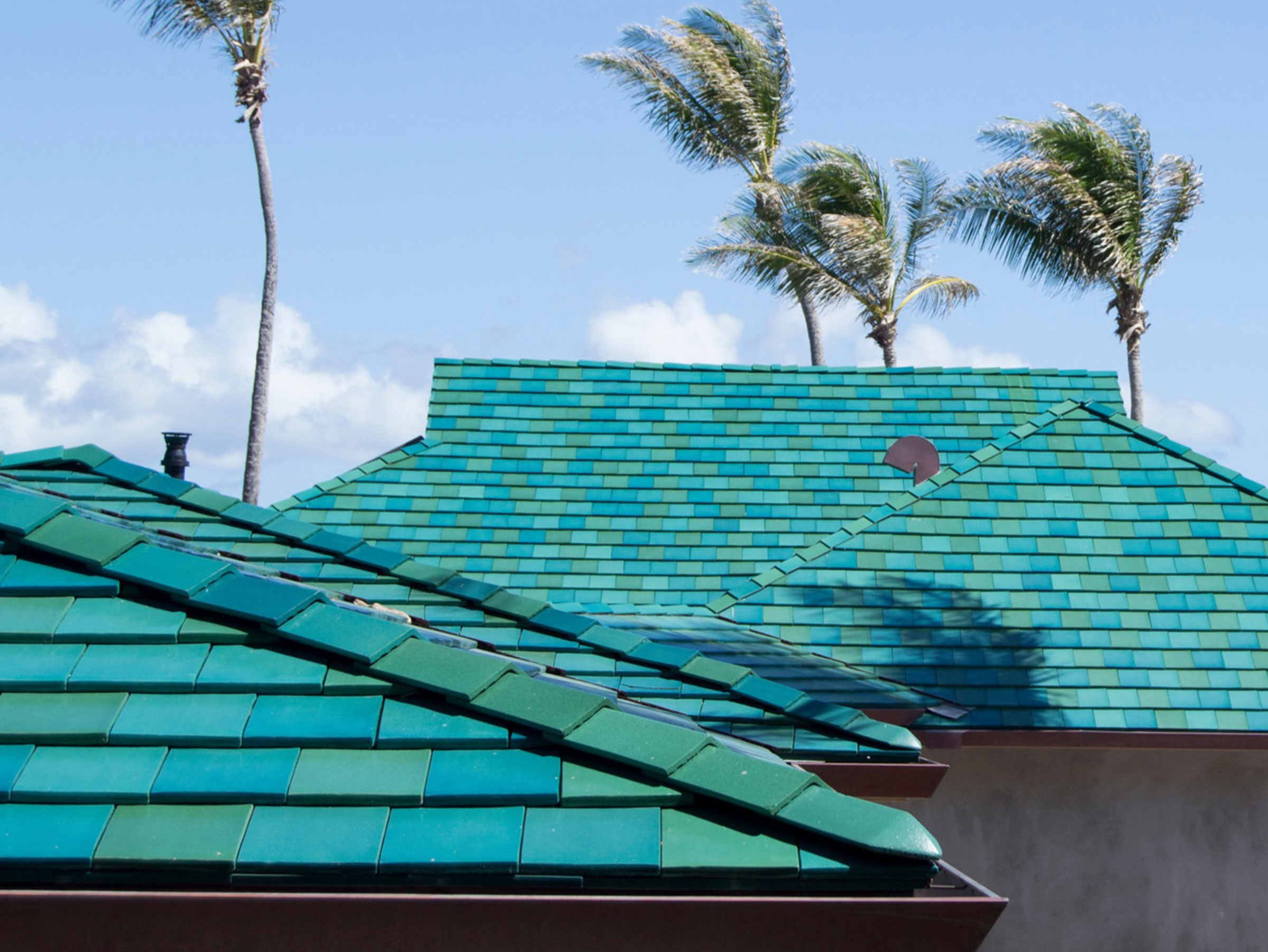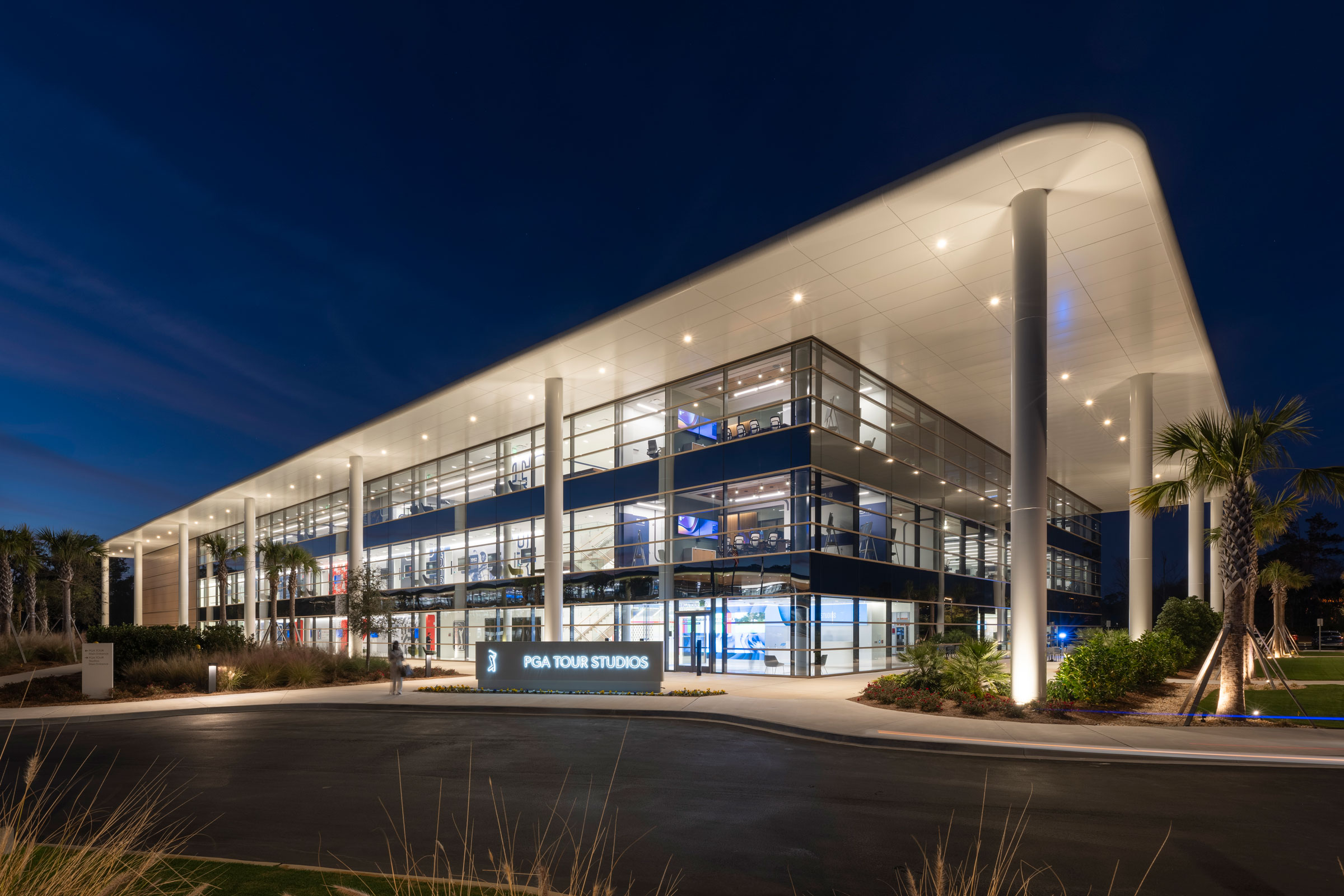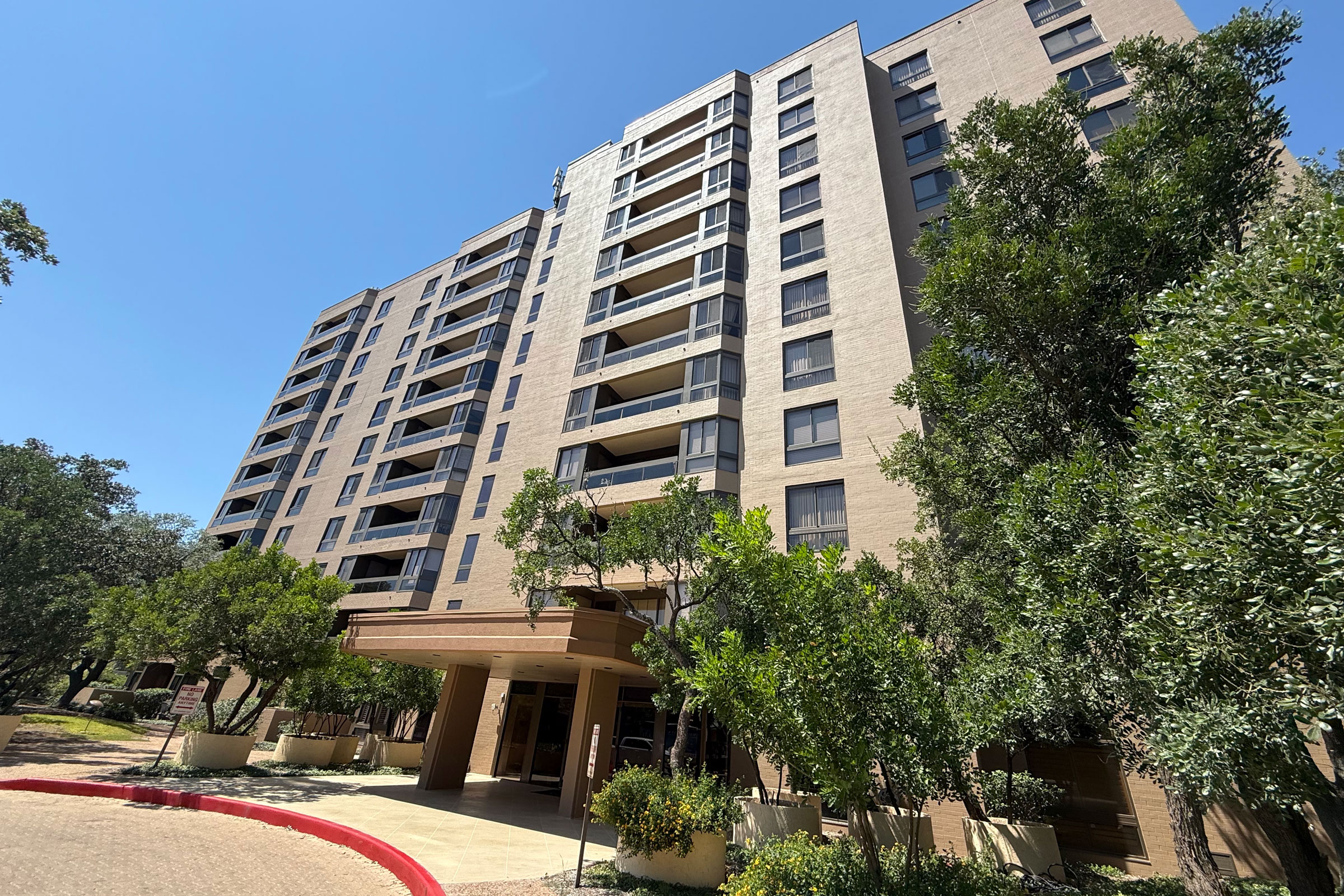Story at a glance:
- Using the right roofing products can protect buildings from extreme weather events and natural disasters.
- Materials like slate, terra-cotta, and steel are easy to recycle and install.
- The solar panel market size is expected to reach $902.55 billion by 2028.
Green building materials come in all shapes and sizes. The global green building materials market size was valued at $256.51 billion in 2020 and is projected to reach $653.41 billion by 2028. This increased demand means more sustainable products will come to the market, but how do you determine what’s best for a particular project?
When it comes to finding sustainable roofing products, professionals have several options to consider. Products that help create an eco-friendlier roof also have benefits like energy savings, reducing heat island effect, and increased durability.
What Makes a Roof Sustainable?
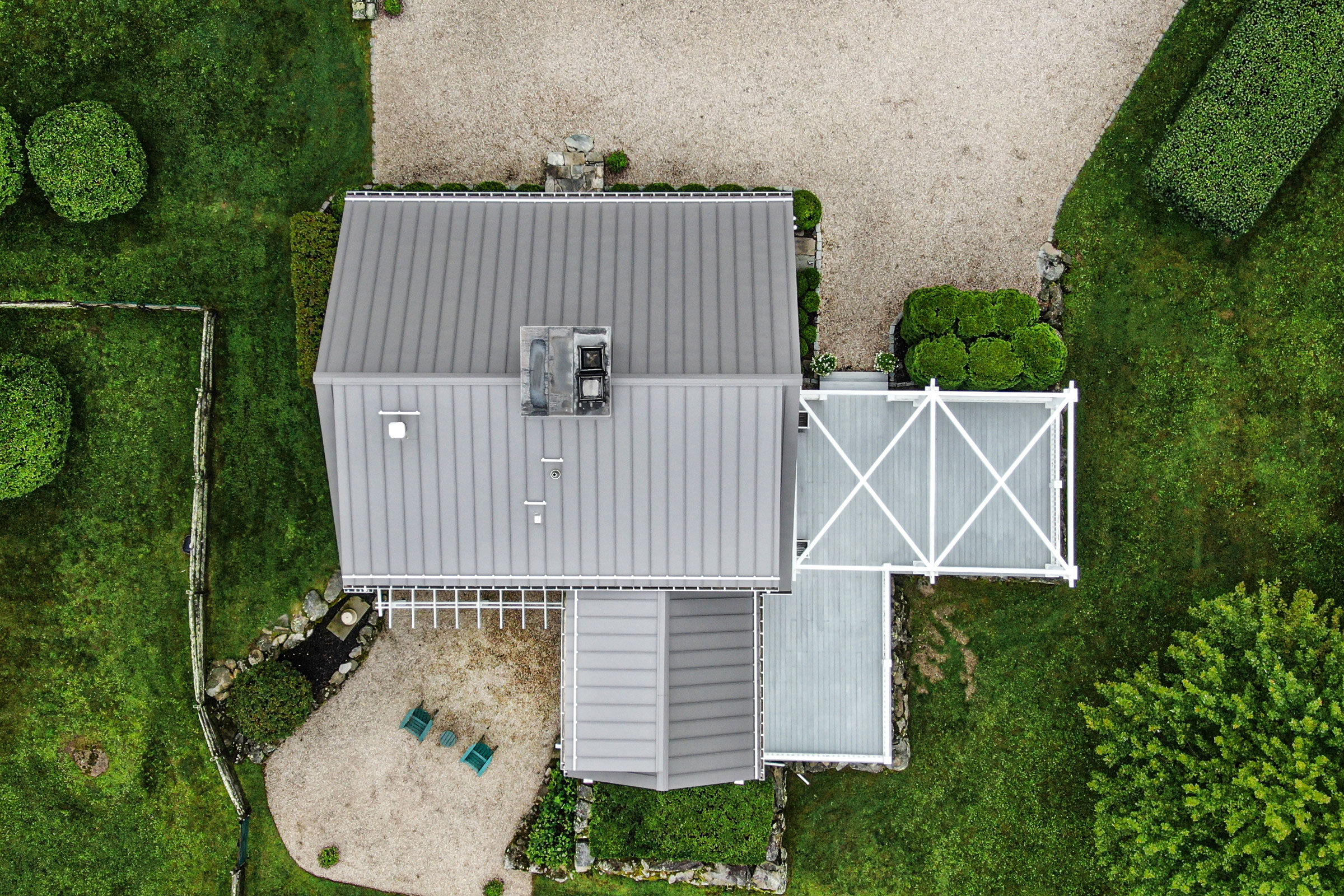
Sustainable roofs are made from eco-friendly materials, possess a high durability, and help reduce a building’s overall energy consumption. Photo courtesy of Englert
A roof’s sustainability ultimately comes down to three things: the materials used in its creation, the roof’s overall durability, and the roof’s contribution to the building’s overall energy consumption.
Truly sustainable roof systems use recycled or environmentally conscious materials that are free from harmful chemicals and compounds, possess a high durability that ensures longevity, and improve a building’s overall energy efficiency by reflecting, exhausting, or effectively mitigating excess solar heat energy.
10 Sustainable Roofing Products
Whether you’re looking to install a new roof or retrofitting an old one, here are 10 sustainable roofing products that may improve your next project.
1. Passive Vents & Exhaust Systems
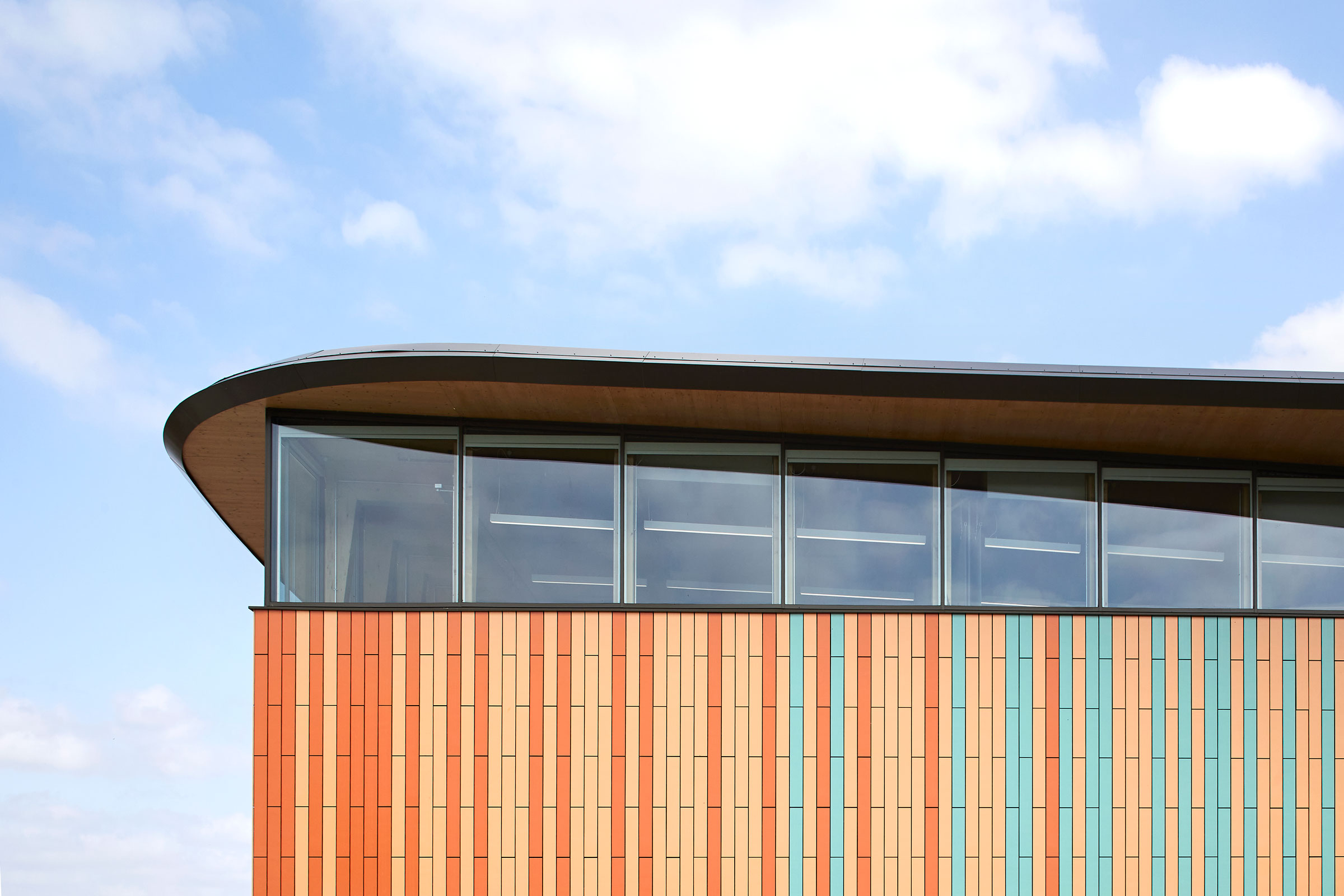
An energy-efficient envelope, passive ventilation strategies, and shading from the roof reduce energy consumption. Photo by Hufton+Crow Photography
All roofs require some form of ventilation to expel heat and moisture. This is especially true for houses with attics, as hot air rises and becomes trapped in these spaces. Most buildings rely on active mechanical systems (i.e. motorized fans) to do the job, but the more sustainable option is passive ventilation.
Passive ventilation systems rely solely on the forces of nature—either wind or buoyancy—to draw in, circulate, and expel air. Because passive roof ventilation systems do not require electricity, buildings that use them consume less energy than those reliant on active ventilation.
There are four main types of passive roof vents:
- Soffit. Often placed under the eaves of a roof; designed to admit rather than expel air.
- Ridge. A long continuous vent that runs beneath the ridge shingles along a roof’s peak; wind and thermal action creates a vacuum effect that pulls hot air out of the building through the vent.
- Gable-end. Louvered rectangular or triangle-shaped vents located at the peak of a gabled roof; these vents are often positioned on either end of a roof and allow air to flow into/out of the building.
- Turbine. Sometimes referred to as whirlybirds, turbine vents rely on wind to expel hot air; when the wind blows in a certain direction, the fan housed inside the vent spins and draws hot air out.
While mechanical in nature, solar exhaust fans are also considered to be sustainable because they are powered by renewable energy rather than the burning of fossil fuels.
2. Wooden Shingles
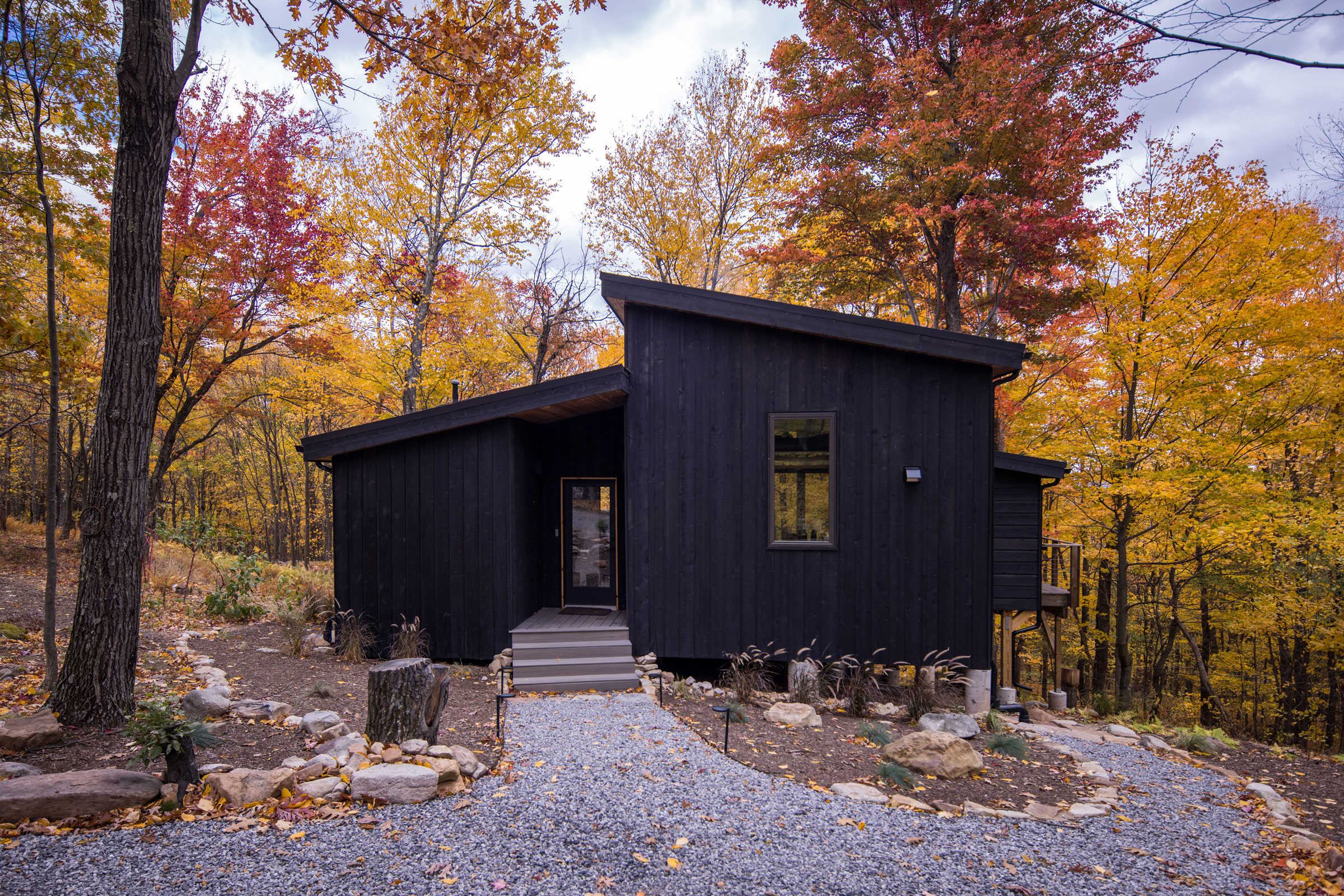
All siding and soffits at the Dolly Sods cabin are western red cedar stained and sealed on both sides. The soffit material is not treated and will age naturally. Photo by Kaarsten Harris
From a sustainability standpoint wooden shingles are some of the most environmentally friendly roofing products on the market, as wood is natural, renewable, and absorbs and sequesters carbon throughout its life cycle—indeed, wood is the only major building material that is renewable. When wooden shingles reach the end of their operational lifespan, they may be composted or allowed to decompose and their nutrients returned to the earth.
Wood that comes from trees in the Cedrus or Cedar genus is considered to be the best for making shingles, as cedar is hardy and possesses a higher resistance to humidity, insects, and rot than many other species. Once installed cedar shingles have an average life expectancy of about 30 years, but with proper care and maintenance cedar shingles can last upwards of 50 years before needing to be replaced.
At the end of the day the true sustainability of wooden shingles is largely dependent on whether the wood is sourced from ethically managed forests that give back more than they take. For this reason it’s recommended that you only consider FSC-certified wooden shingles for your project.
3. Natural Slate Tiles
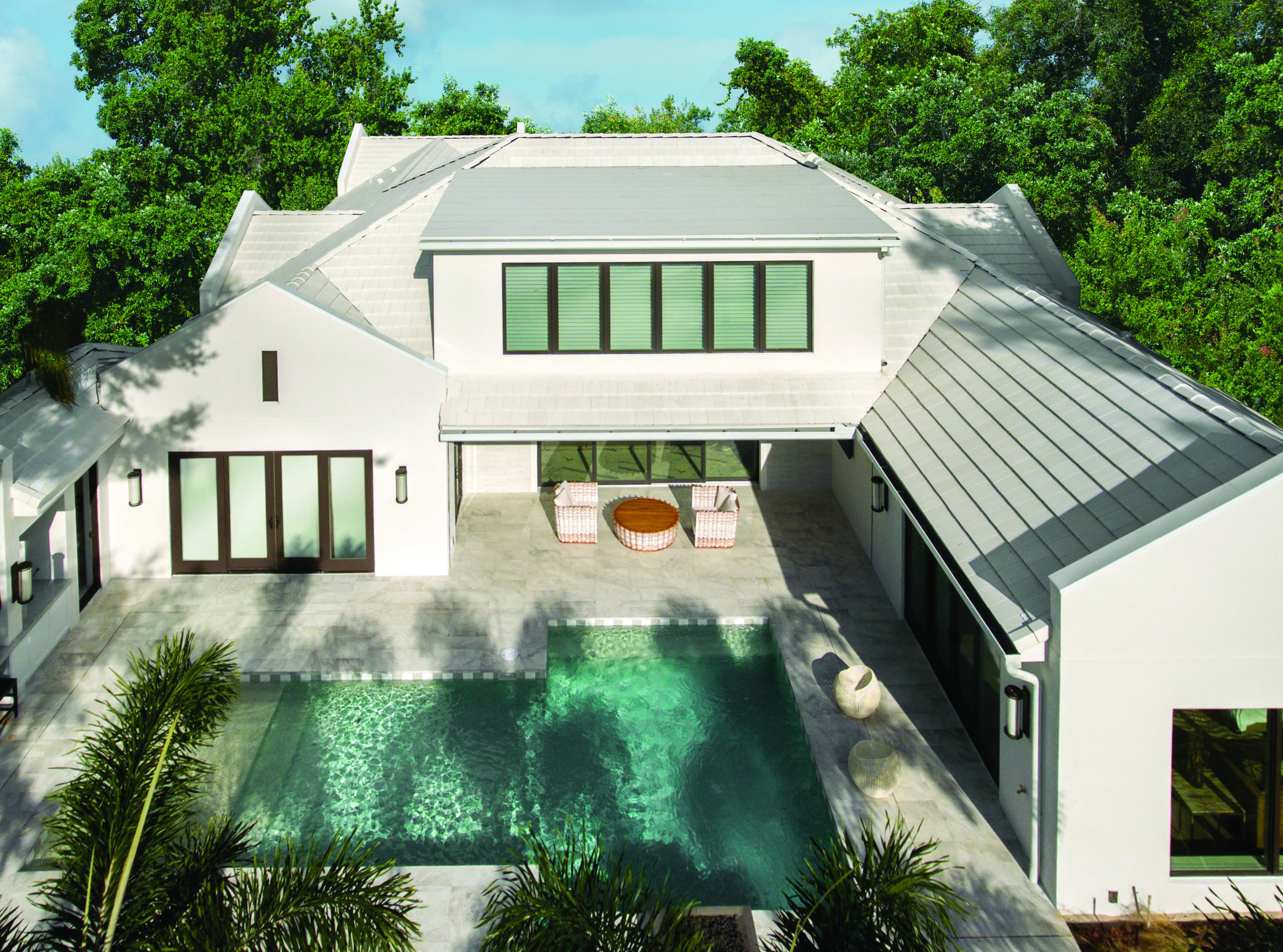
Slate tiles have an incredibly long lifespan and are extremely durable. Photo courtesy of Boral Roofing
Natural slate is one the most popular roofing materials of the last several hundred years—and for good reason. A type of fine-grained metamorphic rock, slate is both visually appealing and extremely weather-resistant, being capable of withstanding everything from wind, frost, rain, and heat with ease.
Slate is also an incredibly strong, durable material—so durable that slate roofs have an average lifespan of 50 to 200 years and often outlast the buildings they are installed on—and possesses a very high resistance to both water and fire. Because of this longevity a large number of slate tiles are already in circulation; these tiles may be reclaimed, recycled, and reused multiple times, greatly increasing their operational lifespan, reducing the amount of waste sent to landfills, and drastically lowering their overall carbon footprint.
Slate’s production process is also fairly low-impact, as once the rock is extracted it only necessitates minimal processing and requires less water, pollutes less, and consumes less energy than most other conventional roofing materials.
4. Blue-Green Roof Systems
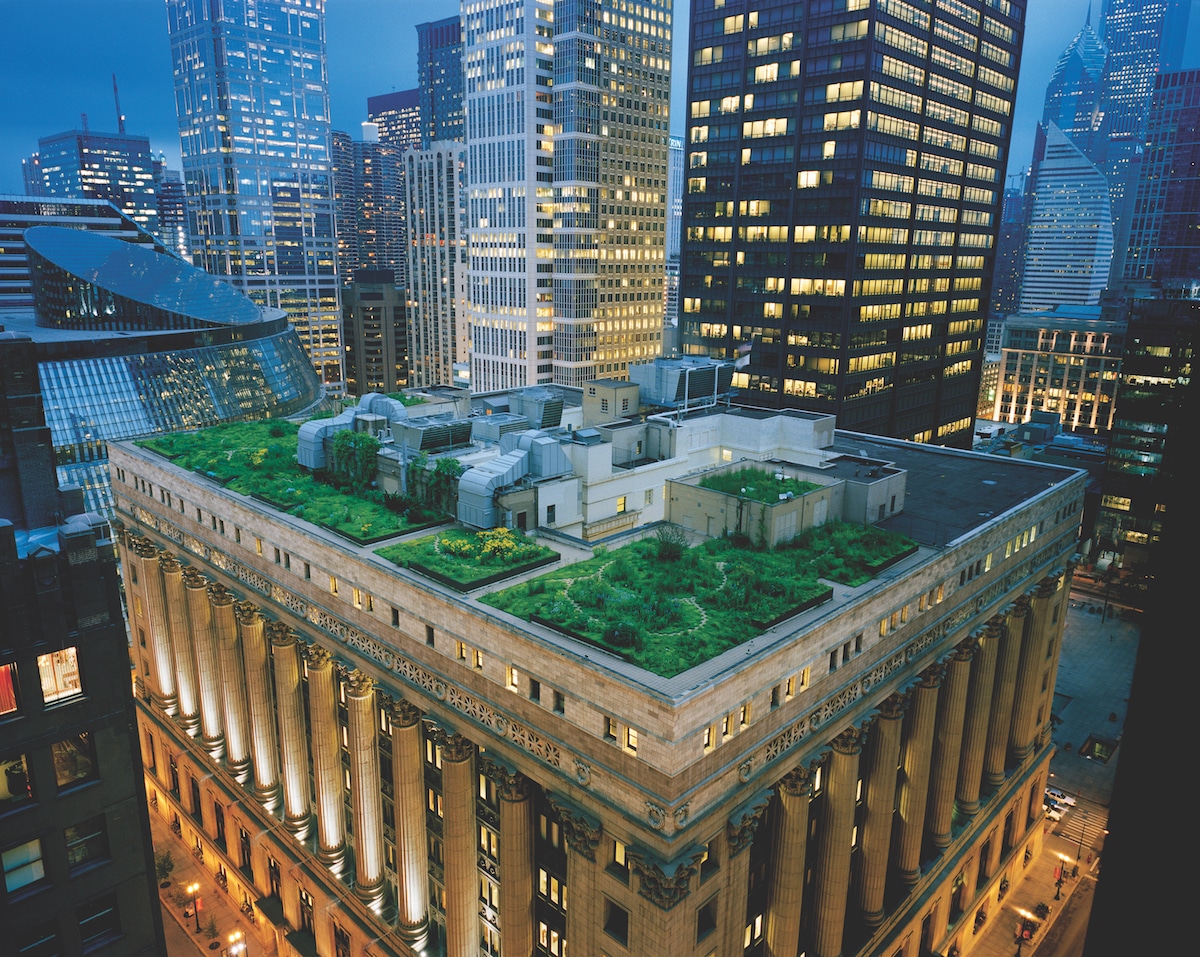
Blue-green roofs like this one at Chicago’s City Hall help keep buildings cool, reduce stormwater runoff, and provide habitats for crucial birds and insects. Photo courtesy of Sika Sarnafil
Blue-green roof systems have been intentionally designed to include both temporary water storage that gradually releases over time (the “blue” part) and a substrate layer that can support the growth of vegetation (the “green” part).
Blue-green roofs provide an added layer of thermal resistance and prevent solar heat transmission through a building’s rooftop materials, thereby reducing dependency on HVAC systems for heating and cooling. On average blue-green roofs reduce air conditioning usage by 75% and heating usage by as much as 23%.
Due to being covered in vegetation, blue-green roofs help mitigate the urban heat island effect by way of evapotranspiration, or the process by which water consumed by plants is changed to vapor and then released into the atmosphere. Blue-green roofs can, on average, be anywhere from 30 to 40°F cooler than traditional rooftops and widespread implementation of these roof systems can reduce city-wide ambient temperatures by as much as 5℉, according to the EPA.
Because of their ability to temporarily store rainwater, blue-green roofs also play an important role in mitigating stormwater runoff, significantly reducing the risk of sewer-system overflow and subsequent urban flooding. Most blue-green roofs are capable of retaining anywhere from 35.5 to 100% of the precipitation that falls during any given period of rainfall and reduce stormwater flow rate by as much as 65%, delaying runoff by up to three hours.
Blue-green roofs can even help to improve social sustainability in that they are beneficial to our mental and physical health. “By offering an aesthetically pleasing landscape, green roofs can reduce stress and increase worker productivity for both building residents and the occupants of nearby buildings,” Michael T. Kozak, vice president of building materials and environmental products for Minerals Technologies, previously wrote for gb&d.
5. Composite Shingles
On average the US produces approximately 40 million tons of plastic waste each year—and roughly 85% of that waste ends up in landfills. Composite shingles allow a portion of that plastic to be recycled and reused to create a long-lasting alternative to conventional asphalt shingles.
A more affordable roofing material than terra-cotta or slate tiles, composite shingles are produced by combining recycled plastic and rubber with other materials like laminate, wood, and synthetic polymers. Most companies mold their composite shingles off of real slate or cedar shingles, which makes the end result a convincing replica of a much more expensive roofing material.
Due to their composition composite shingles are extremely durable and have a very high impact rating, which means you won’t have to worry about severe weather damaging them. Most composite shingles have an expected lifespan of about 50 years—much longer than the 15 to 30 year lifespan of asphalt shingles.
6. Terra-Cotta Tile
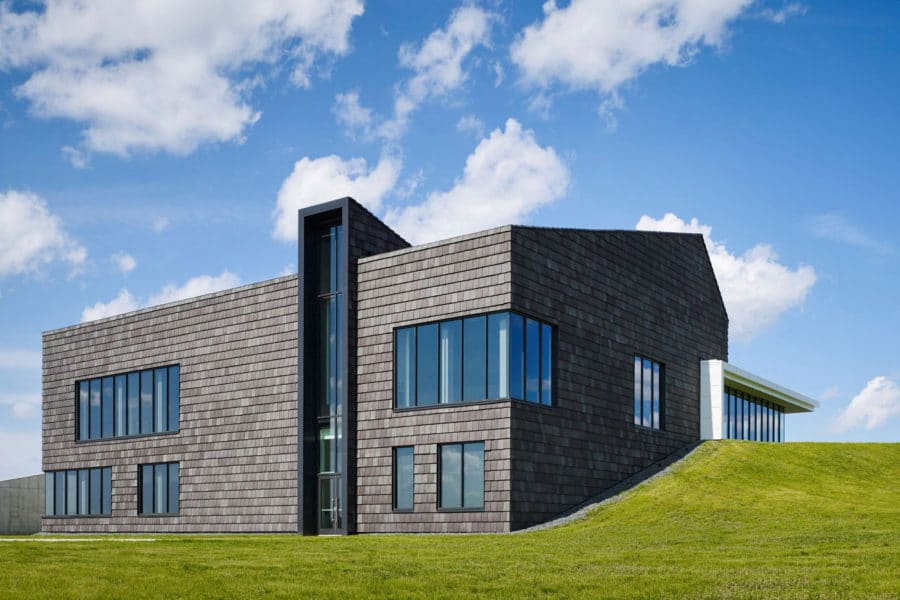
Clay and terra-cotta tiles are extremely weather-resistant, long-lasting, and possess excellent insulative properties. Photo courtesy of Ludowici
Terra-cotta is known for being weather resilient, durable, and recyclable. Terra-cotta roofing tile has been used for centuries and today can even offer a clean and modern look, as manufacturers like Ludowici have shown.
“One question we often get is if terra-cotta products only come in Spanish and Mission styles. Our answer is always definitely not! Today we offer a wide range of architectural terra-cotta products available for roofing, wall cladding, solar shades, and quarry floor tile applications,” said Rob Wehr, vice president of business development and national accounts at Ludowici, in a previous gb&d article. “Many of these products are flat tiles with clean crisp lines that can be used in numerous types of architectural designs. There are also profiles that replicate slate and shake textures and are an excellent alternative to wood shake and natural slate products with the longevity of 75 years.”
Terra-cotta’s benefits continue with its low-maintenance upkeep, fire resistance, and thermal insulation. Terra-cotta allows builders and homeowners alike to take advantage of its benefits without sacrificing style or performance.
“Through superior raw materials, profile engineering, and the manufacturing process, Ludowici tiles are made to withstand more stress than any other clay tile product on the market. The production process allows tiles to form into a dense, vitrified material with the highest strengths available—essential for peak performance,” Wehr previously wrote for gb&d.
7. Solar Reflective Coatings
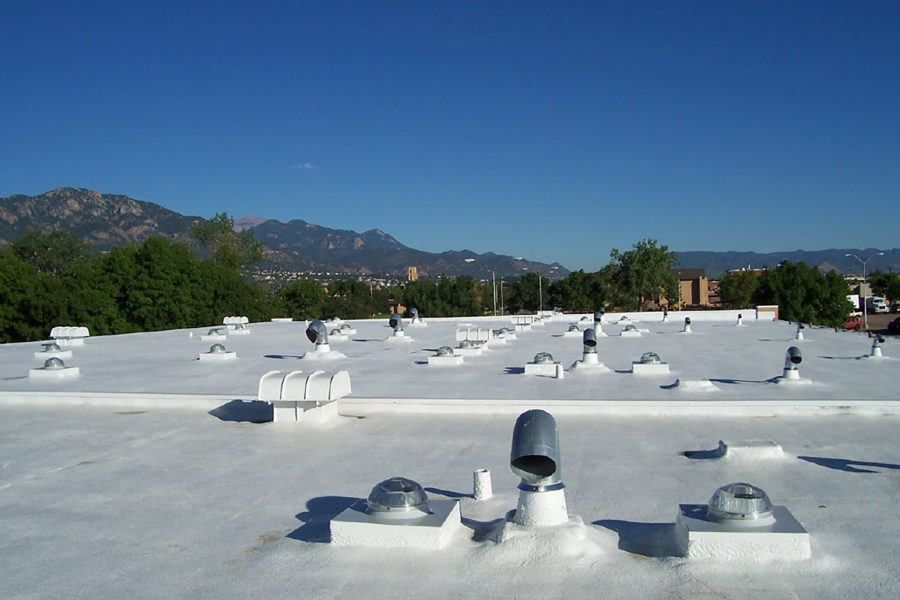
Solar reflective coatings are light-colored and help reflect anywhere from 55% to 90% of the sunlight a roof receives, resulting in a reduced reliance on mechanical air conditioning. Photo courtesy of Covestro
When using protective coatings on a roofing system, there is a lot to consider. The type of coating can be crucial to a roof’s durability and energy efficiency. Materials and methods like silicon, asphalt, acrylic, and polyurethane produce vastly different results. Roof coating experts at Covestro recommend polyurethane coatings for a variety of reasons.
“Liquid-applied polyurethane reflective roof coatings not only ensure lasting durability and easy maintenance; they also have the all-important quality of reflecting sunlight rather than absorbing it—initially as well as years after application,” says Steven Reinstadtler, infrastructure coatings market manager at Covestro. “Dark roofs typically absorb 90% of the sun’s rays, which can drive roof temperatures as high as 150°F on sunny days. Much of this excess heat is absorbed by the building, meaning air conditioning and other cooling systems work harder and consume excess energy. Light-colored roofing, on the other hand, has a higher albedo and reflects anywhere from 55% to 90% of sunlight.”
Versatility is another benefit of solar-reflective polyurethane coatings. This type of coating can be installed over virtually any type of surface, from thermoplastic single-ply membranes like PVC or thermoplastic polyolefin to thermoset single-ply membranes such as ethylene propylene diene terpolymer or chlorosulfonated polyethylene. Polyurethane coatings can also be installed over metal, concrete, built-up roof, modified bitumen, or spray polyurethane foam.
8. Metal Roof Systems
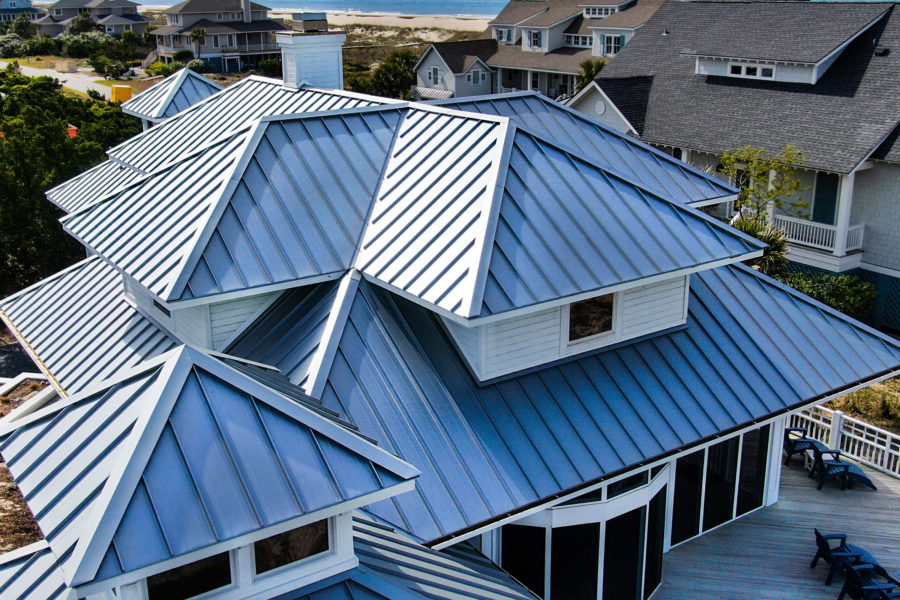
Metal roof systems are incredibly durable, may be recycled, and reflect rather than absorb sunlight. Photo courtesy of Englert
Metal roof systems are sustainable because of their ability to be reused as well as their strength. Steel typically contains a significant amount of recycled content, and all steel is 100% recyclable at the end of its life. That makes metal an ideal alternative to asphalt roofing, which has a negative environmental impact.
“Metal roofing systems outshine competing materials in just about every metric,” Jeff Barnard, technical representative at Englert, previously told gb&d. “But finding a trusted supplier who is familiar with local regulations and testing requirements is the key to success for any roofing project.”
Unlike shingles or slate, metal roofing systems reflect sunlight back into the atmosphere instead of absorbing that heat. This can save on energy costs and the amount of electricity a building uses during warmer months.
In regions that experience extreme weather like hurricanes and snowstorms a metal roofing system’s durability can be beneficial. “When you consider that storms have been getting stronger, it’s become more of a challenge for building code officials to anticipate the necessary requirements ahead of the next big storm,” Barnard says. “We only have about 100 years of climate data to go off of, so every time a new record is broken, local regulators need to adjust their standards. This happens in Florida quite a bit. That’s why Englert is constantly aggressively performing wind uplift and other testing methods, in order to keep pace with the escalating building code requirements.”
9. Solar Panel Systems
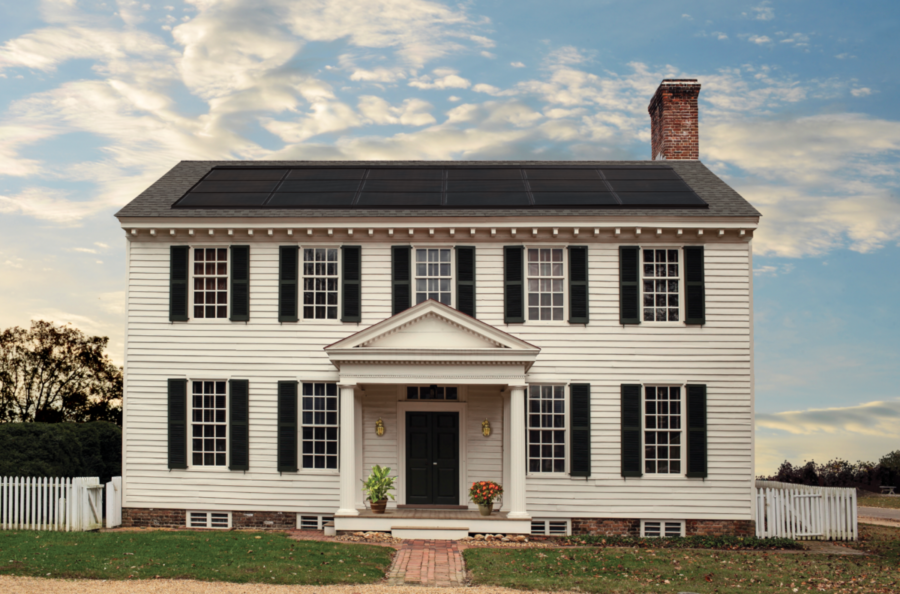
Adding solar panels to a roof is one of the easiest ways to improve sustainability and reduce energy consumption. Photo courtesy of GAF
Solar technology has been around since the 1950s, but with the need for clean energy came an increased demand for solar panels. The solar panel market size reached $182.02 billion in 2021 and is projected to reach $902.55 billion by 2028.
Both commercial and residential buildings can benefit from rooftop solar panel systems, but to get the most out of these systems you need proper planning, design, and installation.
A site analysis must be conducted to determine the sun’s path and any potential structures whose shadows might obstruct the panels throughout the day. Then the roof itself needs to be properly configured to ensure optimal energy collection. If the PV system is being installed on an existing structure, inspectors must determine if the roof is strong enough to handle the weight of the panels or if additional load-bearing framework needs to be installed.
Roofing innovators like GAF offer a range of roofing solutions that continue to advance solar technology. One example can be seen with DecoTech, the low-profile solar system that visually and physically integrates into the roof itself. Using solar as a form of sustainable energy will only get easier with continued advances in solar technology.
There are a number of solar-energy-related tax incentives and government assistance programs in the US, both at the state and federal levels, to help offset the initial costs associated with solar panel installation.
10. Waterproof Liquid Coatings
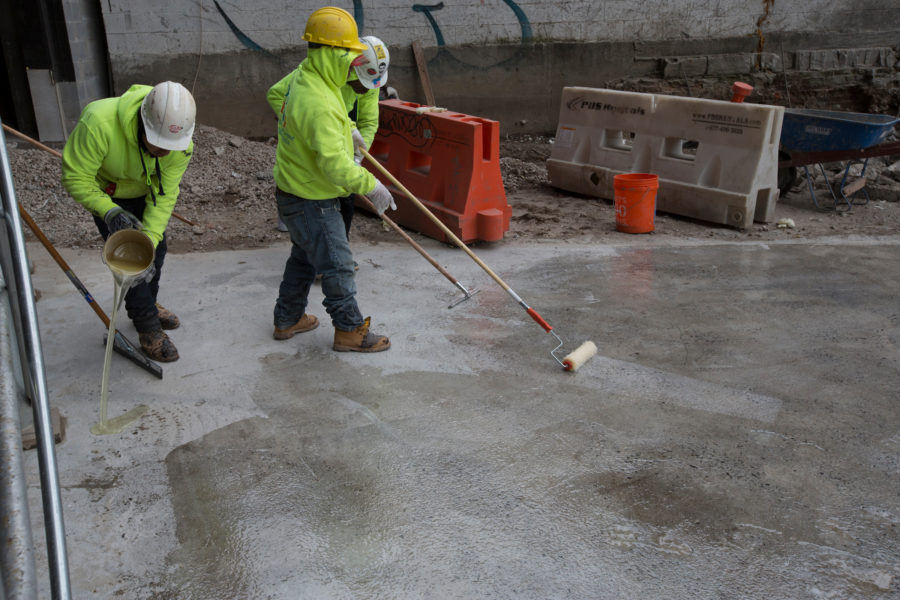
Cold-applied liquid waterproofing can save time and perform better in the long run. Photo courtesy of GCP
Waterproofing new and renovated construction may not be the first thing that comes to mind when you think of sustainable roof design, but it’s a crucial step to take, especially if you’re planning on installing a blue-green roof. Waterproofing a roof can drastically increase its lifespan, improve its overall resiliency against the elements, and helps prevent interior moisture damage.
There are two options to consider when deciding to waterproof a roof: cold- and hot-applied liquid waterproofing. Companies like GCP can help professionals in the industry find the right answer with their variety of waterproofing solutions.
“There are some scenarios in which either cold vs hot-applied liquid waterproofing products work well and even a few in which hot-applied, specifically hot rubberized asphalt (HRA), may be the preferred option,” Lynn Connors, marketing director at GCP, previously wrote for gb&d. “However, for most construction site waterproofing scenarios—particularly the performance-critical and time-sensitive ones—cold-applied liquid waterproofing like GCP’s SILCOR liquid waterproofing line has been proven to be the better option.”
Connors highlights the many scenarios in which cold-applied liquid waterproof coatings can be more effective. Cold-applied coatings are typically a safer option, effective for larger projects, work well with green roofs, and cure much faster.
“The time that it takes for the hot-applied installation to cure or harden and for the surface to be ready for return to service could be 24 hours. The cold-applied installation can withstand foot traffic as well as resist rain in two hours, making it up to 12 times faster than hot-applied to cure, enabling a faster return to service,” Connors says.
Jessica Powers contributed to this article.

